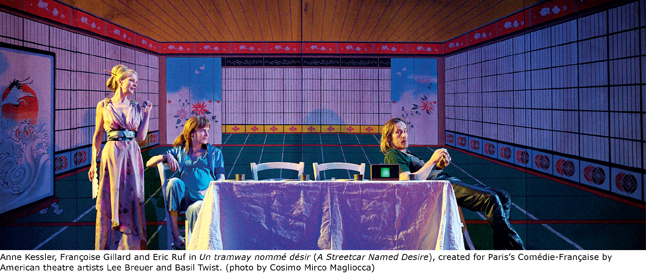
I found this article on the tcg website reviewing a recent production of Tennessee Williams’ A Streetcar Named Desire at the Comedie-Francaise in Paris. This production was directed by Lee Breuer, a fellow art provocateur during the 1970’s with Philip Glass, and involved Japanese silk screens, american biker motifs, Stanislavski and Meyerhold acting styles, as well as the company’s first female artisitc director in its over 300 years of existence, WOW! So, how does this all relate to New Orleans in the 1940s? I’m getting to that. Apparently, Muriel Mayette, now artistic director at the Comdedie-Francaise, thought Breuer the perfect director to debut their first american play ever performed in their main house. Ms. Mayette said she had chosen Breuer because “he is a truly great dramaturg,” a master at reinterpreting classics through a contemporary lense, and the perfect challenge for her acting troupe.
My first reaction to seeing production photos was “WTF?!” At first glance it looked like way too many cooks in one kitchen. Yes, Tennessee Williams’ work is FULL of images, metaphors, motifs and symbols that could place any director in a “candy shop” atmosphere. However, there is a limit that I have as an audience member for how many images I can take before the story loses it’s heart, and I start focusing on the pretty stage pictures. I saw Streetcar when it was produced at Intiman Theatre in Seattle a couple years ago, and I was blown away. It was true to the time, the set and music and costumes screamed french quarter to me, I ate it all up. So I guess my perception of this particular work is clouded by my perception of my first experience with it. Ever since I started taking an interest in acting, the majority of director’s that I’ve worked with have been all about telling the story through the lens of the actors and the work, not the set or the costumes, or the design elements. I firmly believe that some of the best theatre I have ever seen has been with my best friends in a rehearsal space on a late weeknight before auditions. On the other hand, I am one to be dazzled by broadway sparkle and grandeur, but only if it serves the storytelling. Seeing this radical re-imagining of my beloved classic, I was somewhat offended. Why isn’t the original story good enough, I wonder. Why do you have to add Japan and motorcycles and gorillas and silk screens to make the story accessible to a contemporary audience? The thing I love about Steetcar is how raw it is in it’s illustration of how people are able to destroy each other. The human flaws of each of these characters made me fall in love with them, not the design.
The thing that puzzled me most about this article was the fact that the author thought these design elements actually made the characters and storytelling the centerpiece of the production, rather than an add on. So, here we go, how do I unpack this? The article mentioned that Breuer, and his co-creator Basil Twist, are both Japan fanatics and well educated in Japanese puppet art and silk screen storytelling. Breuer was well aware in his execution that the Comedie-Francaise is a very heightened and formalistic space and that the French apparently have a Japanese/Ornate traditional/formalistic fascination. I found the more I read the more intrigued I was as to what his reasons were for each artistic choice. It wasn’t that the article completely won me over to Breuer’s artistic vision, it more opened my eyes to the possibility that each of his choices were made for the benefit of the audience he was directing for. In order for Streetcar to be received by the audience of the Comedie-Francaise, Breuer and his design team had to make stylistic as well as artistic choices in order to make connections between the french quarter or New Orleans in the 1940s, and one of the most prestigious, traditional french playhouses in Paris. Of course there must be some changes made to bridge the gap between the well known film version of american stereotypes to a modern, heightened, european sensibility. I understand the idea of Breuer being a great dramaturg, because he always keeps his audience in mind. His goal as a director is to assist the playwright by playing to the audience that will be receiving his work. I’m not saying I would be able to see Breuer’s production and understand every artistic choice he was making and why, or that I would prefer his production to the Intiman production. I’m coming away from this article more able to sit through said production with an open mind. I’m willing to consider that there is a legitimate and fabulous reason for any artistic choices as long as they are in the interests of making the play accesible to the audience.
